Cycle News Staff | August 2, 2017
2018 GasGas EC/XC 300: FIRST TEST
The rise-of-the-phoenix metaphor is plastered all over the new GasGas effort. It’s even in the press-kit literature, word for word … After being consumed by fire, the Phoenix was reborn from its own ashes…
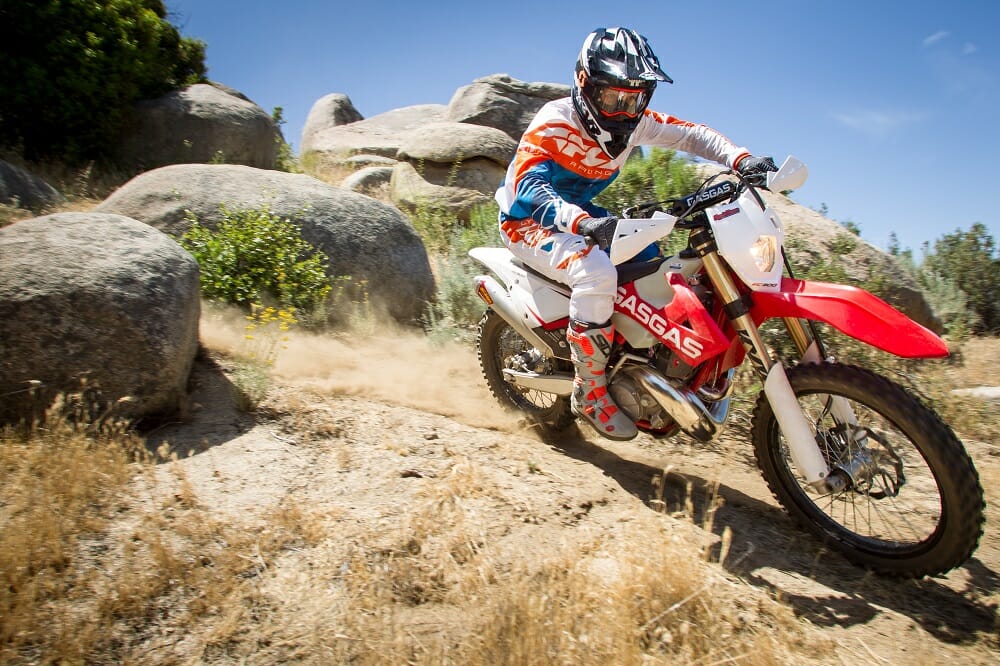 GasGas wants to be a serious player in the off-road game again, hence their all-new and completely revamped 300 XC Racing and 300 EC Racing models.
GasGas wants to be a serious player in the off-road game again, hence their all-new and completely revamped 300 XC Racing and 300 EC Racing models.
But while mythology speaks to strength and a rebirth-of-sorts, what the story of the phoenix doesn’t talk about is timing or strategy. And, with the 2018 re-branding efforts coming to fruition, including all-new motorcycles, GasGas could have just played one of its smartest moves in the dirt.
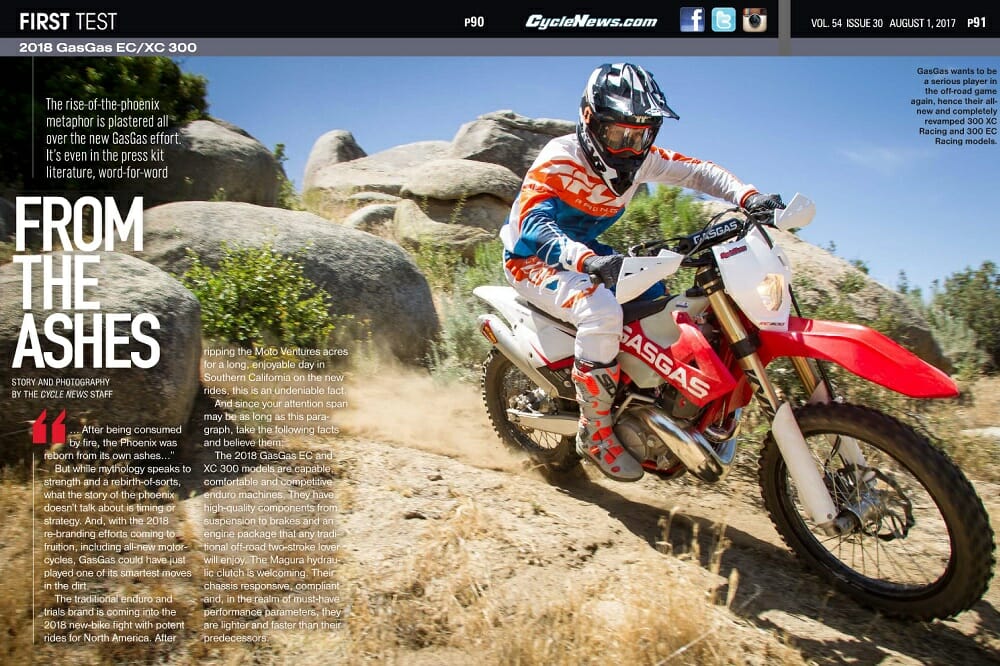
Click here to read this in the Cycle News Digital Edition Magazine.
The traditional enduro and trials brand is coming into the 2018 new-bike fight with potent rides for North America. After ripping the Moto Ventures acres for a long, enjoyable day in Southern California on the new rides, this is an undeniable fact.
And since your attention span may be as long as this paragraph, take the following facts and believe them:
The 2018 GasGas EC and XC 300 models are capable, comfortable and competitive enduro machines. They have high-quality components from suspension to brakes and an engine package that any traditional off-road two-stroke lover will enjoy. The Magura hydraulic clutch is welcoming. Their chassis responsive, compliant and, in the realm of must-have performance parameters, they are lighter and faster than their predecessors.
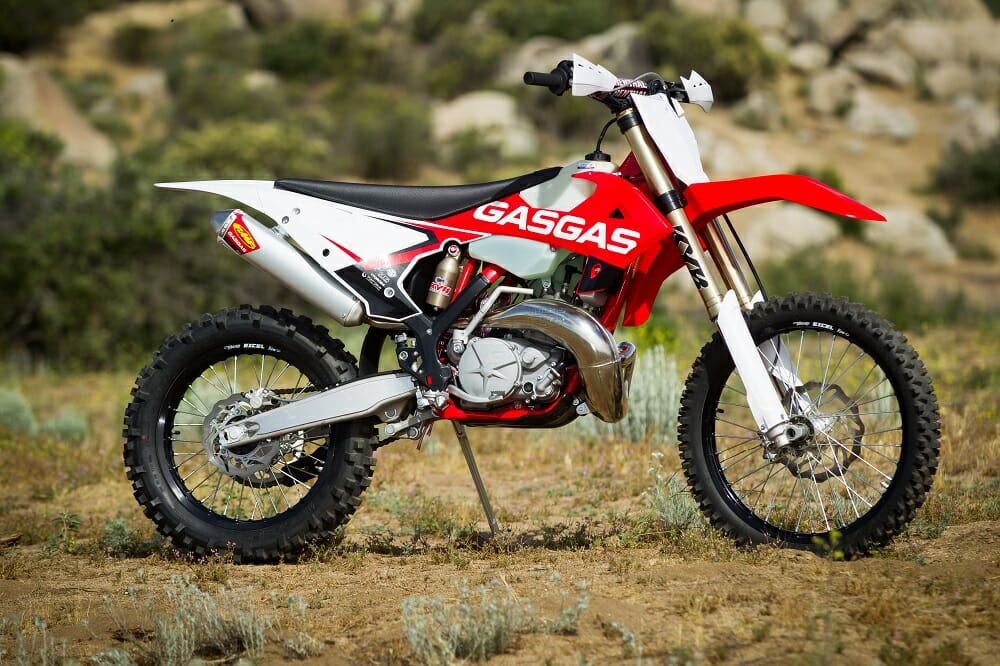 The XC is ready to go racing right out of the box.
The XC is ready to go racing right out of the box.
And while new bikes should be the story here, let’s not forget the company was recently saved from extinction, restructured/consolidated multiple sales and distribution channels, and has added an all-star cast of American off-road, trials and motorcycle racing greats on-board to drive the new bikes forward.
The bottom line: GasGas is here to compete.
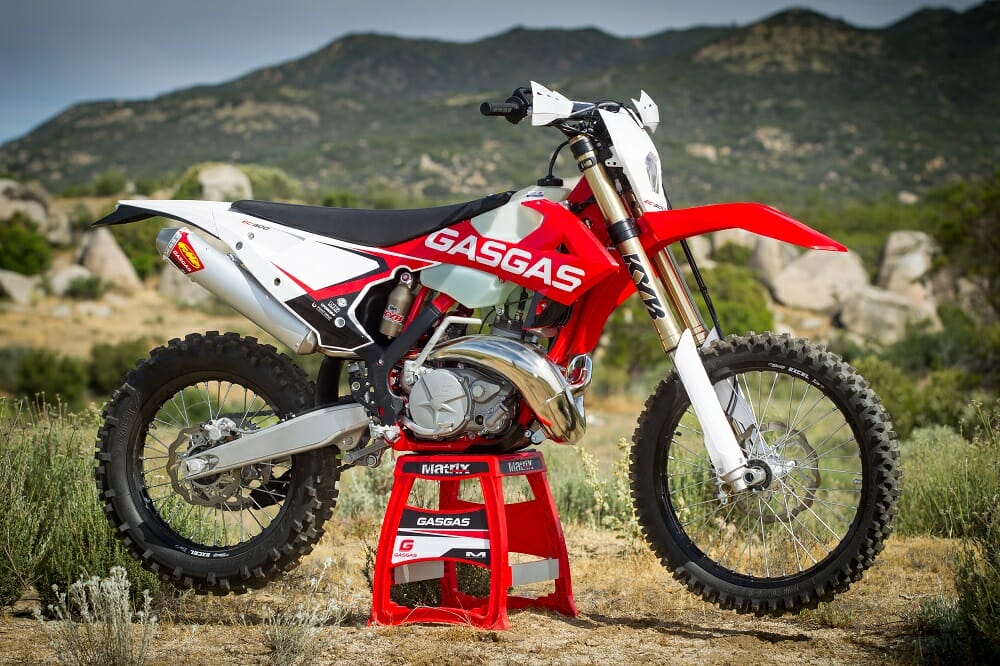 The EC is essentially an XC but with lights, enduro computer and different handlebars.
The EC is essentially an XC but with lights, enduro computer and different handlebars.
Now, let’s get back to the bike business.
GasGas is bringing two new 300 two-stroke enduro machines to the U.S. dirt. The EC and XC versions are very similar but aimed at different groups or intended use.
Across the board the EC/XC share the massive updates that make GasGas new. Don’t compare these to older GasGas bikes, as the only thing they share with the old models is the color scheme and engine components. Otherwise, the entire bike is new.
They have a new, modern, central backbone steel frame, a new aluminum sub frame, new airbox and air filter, new footpegs, new side stand, new skid plate, new Kayaba suspension front and rear, new swingarm, new linkage, new chain guides, new Excel rims, new brakes, new engine components, new electrical/wiring systems, new light and control switches, new batteries, new e-start systems… you get the idea.
Two-stroke lovers will rejoice in seeing the Keihin PWK 38mm carb coming on these bikes. Our bikes were leaned out from stock to work well at around 3000 feet. And we know from experience the setup options for these carbs are vast, proving their performance from the ocean to high-country Colorado.
 We are impressed with the GG’s KYB suspension, both front and rear.
We are impressed with the GG’s KYB suspension, both front and rear.
Off-roaders will also be glad to see a six-speed gearbox and 2.64-gallon fuel tank, offering decent range.
The EC 300 is the more “Euro” enduro here and is set apart visually from the race-style XC by the integrated headlight and taillight assemblies.
You can’t see it, but under the EC’s skin is a Euro-style wiring harness connecting to the control switch at the bar. This switch has functions (blinkers and horn and the like) that don’t work on this bike, but they’re there anyway in case you want to slap some blinkers on or toot a horn. Also, the EC features a stock GasGas pipe with an FMF silencer, a different handlebar with a different bend compared to the XC and a capable-yet-simple enduro computer.
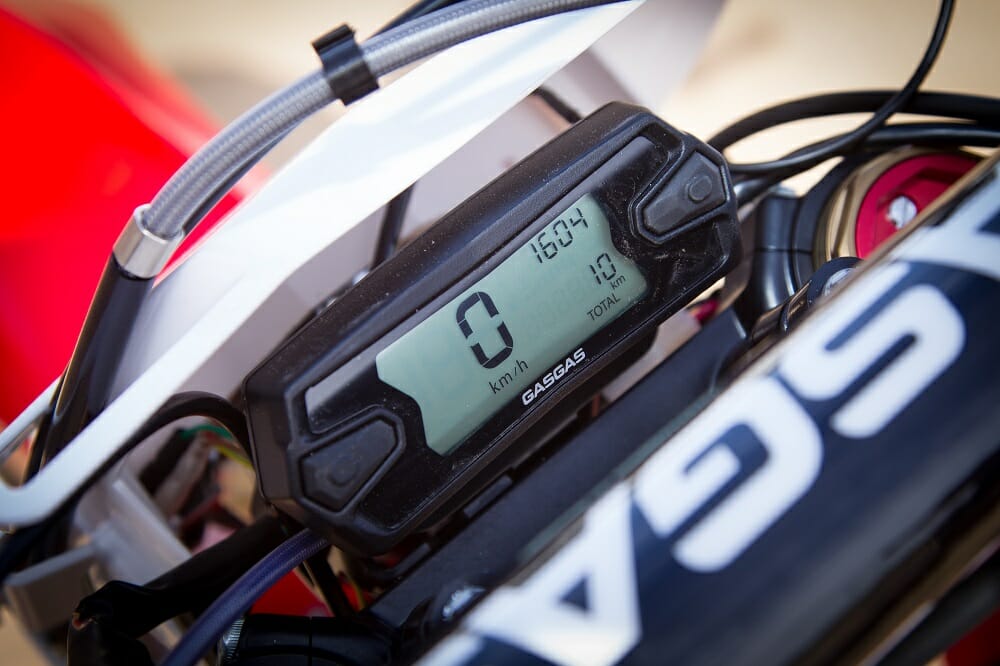 The EC is fitted with a handy enduro computer.
The EC is fitted with a handy enduro computer.
The XC is the race bike. Although the chassis and suspension settings are identical to the EC—as is the engine configuration, ignition mapping, carburetor, etc.—the bike takes on a more aggressive character through headlight and taillight omission and a full FMF exhaust system. Additionally, the XC saves a bit of complexity and weight with a unique wiring harness that eliminates the additional control switch at the bar and the wires that come with it. A Renthal Twinwall handles the control duties on the XC—adding a nice ergonomic upgrade over the somewhat awkward and compact bend of the stock EC bar.
Our EC test bike was fitted with a spark arrestor whereas the XC was not. GasGas officials told us neither would be coming with a sparky when they hit dealerships. The spark arrestor likely had a little to do with the power delivery differences we experienced with the two bikes.
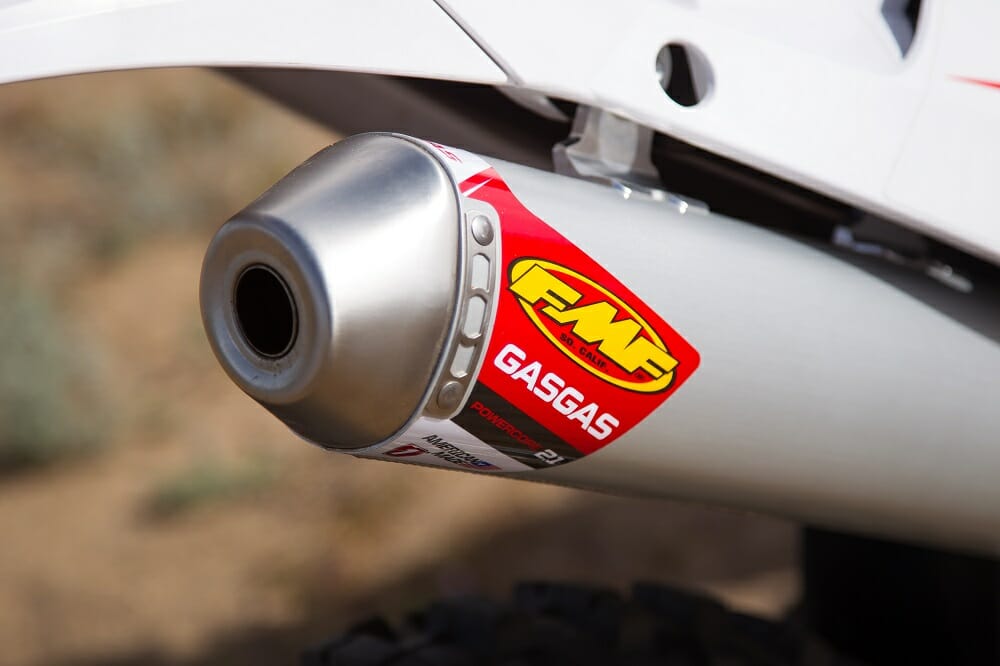 Both bikes feature GasGas built exhaust pipes with FMF mufflers; you’ll have to supply the spark arrestor, though.
Both bikes feature GasGas built exhaust pipes with FMF mufflers; you’ll have to supply the spark arrestor, though.
That’s really the difference between the two. But it’s quite interesting how much some lights, a wiring harness, exhaust and a handlebar can do to the power and handling characteristics of a bike.
The EC rides, as you’d possibly predict, with the smoothest power delivery and least amount of outright excitement of the two. It produces great torque and resists stalling in the technical stuff with the best of them. We repeatedly lugged the bike out of technical uphill turns without a problem—the bike grabbing traction and pulling forward every time. It really does hold that magical 300 power character right in the sweet spot.
The EC is a bike that can pull serious torque duty in technical off-road. As you accelerate, the power really wants to put traction down and the bike resists spinning out through the rpm arc—favoring a more plush and controlled delivery of horsepower than one reliant on revs.
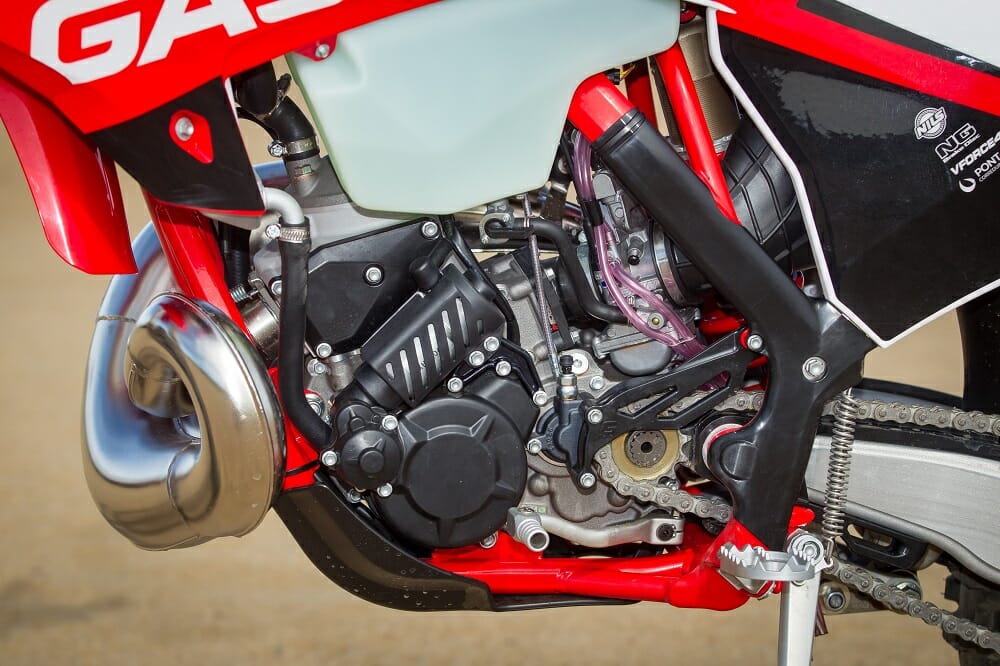 You want torque? You go it with the XC/EC’s 299.3cc displacement and square-bore configuration.
You want torque? You go it with the XC/EC’s 299.3cc displacement and square-bore configuration.
The EC handling is the only awkward part of the lineup. And this is due mostly to a compact bar bend with what feels like is a lot of sweep built into the bend. It sort of amplifies the additional weight feel of the headlight and computer mounted on the bike and makes it a bit lethargic in comparison to the more nimble XC. This is a handlebar issue, most likely, and nothing else. So it’s a subjective knock, at best.
The XC, by contrast, has amplified throttle response, more precise-feeling handling and a more-accelerated transition of power from bottom to top. It gets into midrange grunt out of the bottom-pull faster than the EC and carries the top-end with more aggression but not outright snap. Bottom-end power and delivery isn’t necessarily sacrificed with the more aggressive feeling. So, don’t worry about losing too much in the technical traction department if you opt for an XC model.
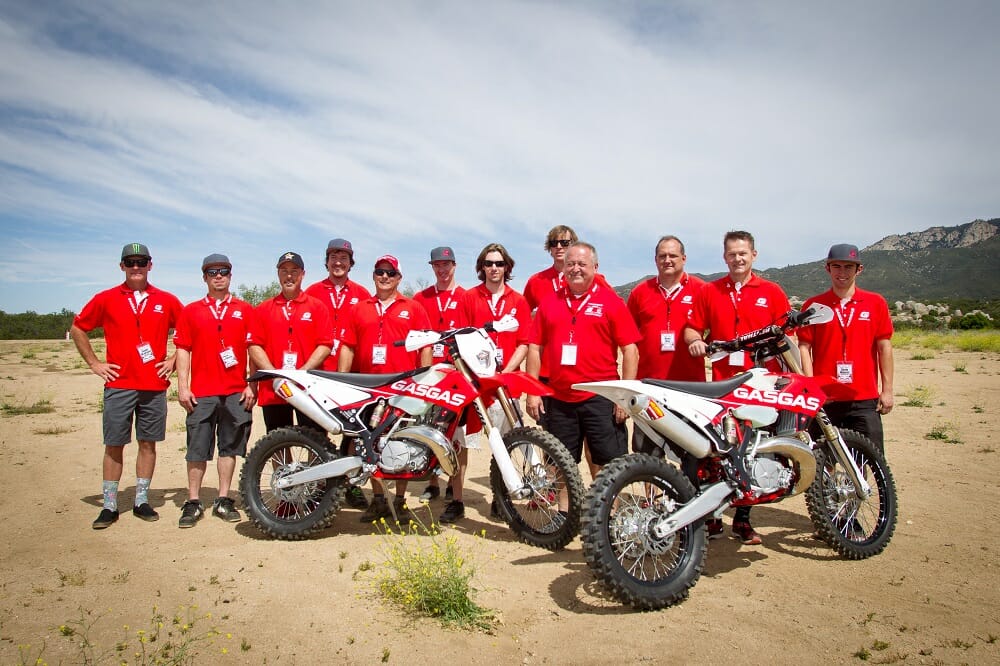 GasGas has bolstered its off-road team with former off-road champs Fred Andrews, Steve Hatch and Geoff Aaron, as well as former 250SX champ Damon Bradshaw.
GasGas has bolstered its off-road team with former off-road champs Fred Andrews, Steve Hatch and Geoff Aaron, as well as former 250SX champ Damon Bradshaw.
Likewise, the XC seems to dance around obstacles with more ease. This is likely due to some reduced weight from the wiring harness and light/computer systems as well as more leverage from a more comfortable bend on the Twinwalls.
Both bikes have identical suspension components and settings, and they’re great if not a little stiff initially for gnarly off-road. While we didn’t feel any compliant issues with small bumps in our testing, we know there is rockier and sharper-edge terrain out there that will test the KYB’s movements. The great news, it’s a system that is easily tunable and customizable thanks to a massive aftermarket support system of suspension shops and more standard componentry than GasGas has employed on their bikes in the past.
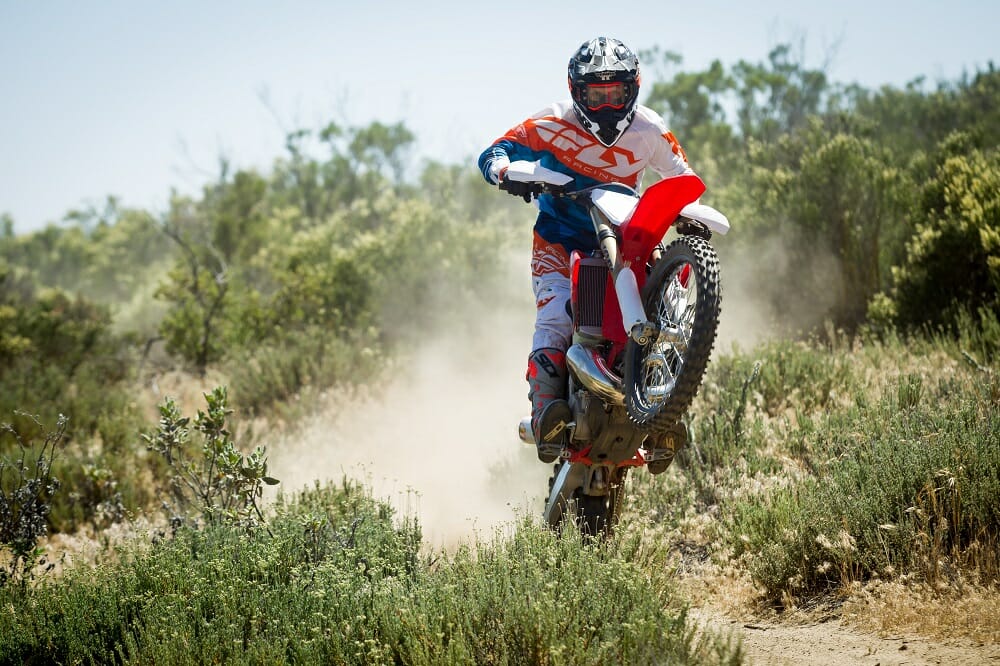 Looking for a new two-stroke off-road bike? The new 300 XC and ECs from Gas Gas are well worth looking into.
Looking for a new two-stroke off-road bike? The new 300 XC and ECs from Gas Gas are well worth looking into.
Out of the box, this is a true “competition” suspension setting with major hold-up behavior and massive bottoming resistance for an off-road bike.
For us, the bike to buy out of the 2018 GasGas lineup is the XC. It offers all of the usable power traits of the EC with the added benefit of some excitement and amplified competitiveness with better ergonomics. It’s a capable competition bike and a great enduro machine.
An EC with a full FMF exhaust system and, possibly, without the spark arrestor, could easily mimic this power, but if you’re buying it for the headlight, there are clearly more powerful options there in the aftermarket. CN
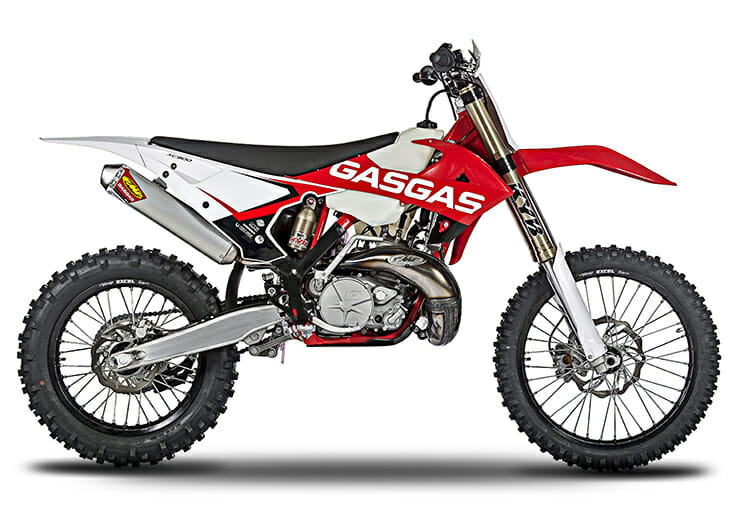
SPECIFICATIONS
|
2018 GasGas XC Racing ($8999)/EC Racing ($9299)
|
|
ENGINE:
|
Liquid-cooled, 2-stroke, single
|
|
DISPLACEMENT:
|
299.3cc
|
|
BORE X STROKE:
|
72.0mm x 72.0mm
|
|
FUEL DELIVERY:
|
Keihin PWK 38mm carburetor
|
|
STARTING SYSTEM:
|
Electric and kick
|
|
TRANSMISSION:
|
6-speed
|
|
FRAME:
|
Steel
|
|
FRONT SUSPENSION:
|
KYB 48mm AOS closed-cartridge, spring fork
|
|
REAR SUSPENSION:
|
KYB adj. high/low-speed compression and rebound
|
|
FRONT WHEEL TRAVEL:
|
11.8 in.
|
|
REAR WHEEL TRAVEL:
|
11.9 in.
|
|
FRONT WHEEL:
|
Excel 1.6×21 in. Metzler Six Days 90/90-21
|
|
REAR WHEEL:
|
Excel 2.15×18 in. Metzler Six Days 140/80-18
|
|
FRONT BRAKE:
|
Nissin disc
|
|
REAR BRAKE:
|
Nissin disc
|
|
SEAT HEIGHT:
|
37.8 in.
|
|
WHEELBASE:
|
58.3 in.
|
|
FUEL CAPACITY:
|
2.64 gal.
|
|
WEIGHT (claimed dry):
|
231.5 lbs.
|